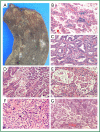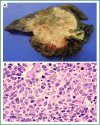The pivotal role of pathology in the management of lung cancer
- PMID: 24163740
- PMCID: PMC3804871
- DOI: 10.3978/j.issn.2072-1439.2013.08.43
The pivotal role of pathology in the management of lung cancer
Abstract
The last decade has seen significant advances in our understanding of lung cancer biology and management. Identification of key driver events in lung carcinogenesis has contributed to the development of targeted lung cancer therapies, heralding the era of personalised medicine for lung cancer. As a result, histological subtyping and molecular testing has become of paramount importance, placing increasing demands on often small diagnostic specimens. This has triggered the review and development of the first structured classification of lung cancer in small biopsy/cytology specimens and a new classification of lung adenocarcinoma from the IASLC/ATS/ERS. These have enhanced the clinical relevance of pathological diagnosis, and emphasise the role of the modern surgical pathologist as an integral member of the multidisciplinary team, playing a crucial role in clinical trials and determining appropriate and timely management for patients with lung cancer.
Keywords: Lung Neoplasms; non-small-cell lung carcinoma (NSCLC); pathology; small cell lung carcinoma (SCLC).
Figures







References
-
- Ferlay J, Shin HR, Bray F, et al. Estimates of worldwide burden of cancer in 2008: GLOBOCAN 2008. Int J Cancer 2010;127:2893-917 - PubMed
-
- Australian Bureau of Statistics. Causes of Death Australia 2009. Australian Government, ABS. 2011. http://www.abs.gov.au/AUSSTATS/abs@.nsf/Latestproducts/3303.0Contents200... Accessed 26 February 2012.
-
- Naruke T, Tsuchiya R, Kondo H, et al. Implications of staging in lung cancer. Chest 1997;112:242S-8S - PubMed
-
- Nesbitt JC, Putnam JB, Jr, Walsh GL, et al. Survival in early-stage non-small cell lung cancer. Ann Thorac Surg 1995;60:466-72 - PubMed
-
- Australian Bureau of Statistics. Causes of Death, Australia, 2004. Australian Government, ABS. 2006. http://www.abs.gov.au/Ausstats/abs@.nsf/b06660592430724fca2568b5007b8619... Accessed 2 October 2006.
Publication types
Grants and funding
LinkOut - more resources
Full Text Sources
Research Materials
